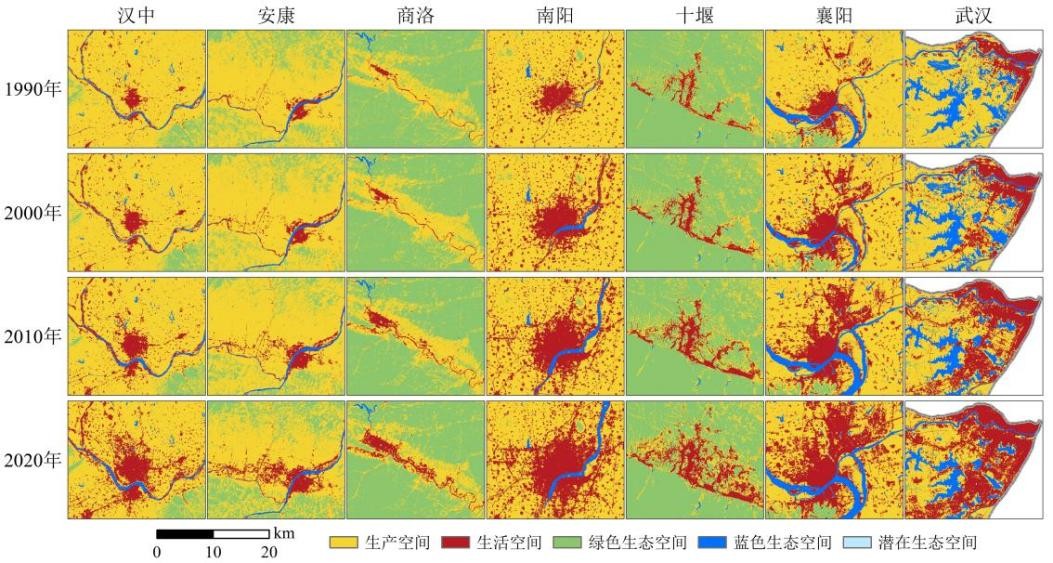-
伴随着中国经济社会高速发展、城镇化快速推进,“生产—生活—生态”(三生)土地利用的空间争地冲突现象愈发强烈:生态空间被生产、生活空间挤压[1],城镇空间扩张占用优质耕地资源[2],平衡耕地占用大量林、草生态用地[3-4],从而引发区域生态系统脆弱等一系列问题。面对发展困境,党的十八大报告明确提出要构建“生产空间集约高效、生活空间宜居适度、生态空间山清水秀”国土空间开发目标,十九大进一步强调“坚定走生产发展、生活富裕、生态良好的文明发展道路”[5],二十大指出应“坚持山水林田湖草沙一体化保护和系统治理”。基于此,国内专家学者将土地利用转型与国土空间开发相联系,集中研究了全球[6]、国家[7-9]、省域[10-11]、城市及城市群[12-13]、县域[14]、村域[15]和中国重要生态区[16]等多空间尺度下三生空间的功能评价[8,11-12,15]与演变转型[9,12-13,16]、生态环境效应[9,16]及其影响因素[9,13]等,这些为我国生态文明建设积累了丰富成果;但对流域尺度研究相对较少。作为集自然、社会、经济于一体的复合系统,流域兼具生产、生活、生态功能[17],是生态文明和经济文明建设重要载体。如黄河流域城镇空间不断侵占农业空间和生态空间[18],但其生态环境总体上不断改善[19];湘江流域出现了生态空间缩减、生产和生活空间激增[20];汾河流域因历史生态欠账较多,生产—生活—生态空间功能处于低水平耦合协调[17];受毁林开荒和退耕还林还草过程,白龙江流域生态系统服务功能发生显著变化[21],以上研究有力支撑了流域土地可持续利用和高质量发展。
汉江流域(30°8′N—34°11′N,106°12′E—114°14′E)地处中国南北气候交接地带,涉及鄂陕川渝甘5省市78个县,是我国重要的生态功能区、南水北调中线工程的水源地,在国家区域生态安全和经济社会发展格局中的战略地位日益凸显[22]。1980—2010年间湖北汉江流域耕地面积减少最大,主要转移方向为建设用地和水域,生态服务价值呈先增长、后降低态势[23]。近年来,我国国土空间规划处于快速发展时期[24],亟需了解汉江流域土地利用结构及其生态环境的最新动态。鉴于此,本文以1990—2020年汉江流域四期土地利用为基础数据,基于三生空间视角,结合GIS空间分析技术,探索研究区用地类型转移对区域生态环境效应的影响,以期为汉江流域的生态文明建设和国土空间规划提供决策依据。
-
本文土地利用数据来于中国年土地覆盖产品[25],其空间精度为30 m×30 m,包含耕地、林地、灌木、草地、水体、雪/冰地、未利用土地、建设用地、湿地等用地类型。该数据基于Google Earth Engine上Landsat影像,结合中国土地利用/覆盖数据集(China's Land-Use/Cover Datasets, CLUD)提取的稳定样本进行可视化解译;然后通过所有可用的Landsat数据构建多个时间度量,并将其输入随机森林分类器以获得分类结果,时空一致性高。参考前期研究成果[26],结合汉江流域实际情况,本文将耕地类型归为生产空间(production space, PS)、建设用地归为生活空间(living space, LS)、其他用地类型归为生态空间(ecological space, ES),进一步林地、灌木地和草地归为绿色生态空间(GES),水体和湿地归为蓝色生态空间(BES),未利用土地归为潜在生态空间(PES)。
-
以矩阵方式表示汉江流域三生空间的转移面积,能够精准掌握研究区三生功能用地的时序演变过程,见式(1):
式中:S为转移总面积(km2);m、n分别为研究期初、末期的三生空间类型。
-
生态环境质量是基于土地利用/覆被数据测算生态环境质量的主要方法[27],可定量反映某一区域(行政区、流域)生态环境质量的总体特征[16]。本文采用等间距采样法创建5 km×5 km渔网,以网格法计算各空间单元内的各地类的生态环境质量,见式(2):
式中:
$ EI $ 表示网格单元的生态环境质量,$ {A}_{\mathrm{h}\mathrm{f}} $ 为网格单元内用地类型f的面积(km2),$ {A}_{\mathrm{h}} $ 为网格单元的面积(km2),n为用地类型的数目;$ {R}_{\mathrm{f}} $ 为第f类用地类型的生态环境质量指数,参照已有研究成果[9,16],PS、LS、BES和PES类型的$ {R}_{\mathrm{f}} $ 分别取0.263、0.200、0.697、0.045,草地绿色生态空间(GGES)类型的$ {R}_{\mathrm{f}} $ 取0.465,林地和灌木地绿色生态空间(FGES)类型的$ {R}_{f} $ 取0.796。 -
生态贡献率LEI是指测算土地利用转型过程中对区域生态环境质量的改善或恶化影响程度[9],见式(3):
式中,
$ {LE}_{\mathrm{t}+1} $ 和$ {LE}_{\mathrm{t}} $ 分别反映用地类型变化末期和初期的生态环境质量指数,$ LA $ 则代表该用地类型的面积(km2),$ TA $ 表示汉江流域的总面积(km2)。 -
1990—2020年汉江流域三生空间类型以生态空间为主,生产空间次之,生活空间最小,见表1。
具体来看,汉江流域生产空间面积呈“小幅增加—减少—大幅减少”波动特征,由1990年的57 316.7 km2降至2020年的52 834.3 km2,减少了4 482.5 km2,年均减少0.27%。生活空间面积始终处于增加态势,表现为“大幅增加—增加—大幅增加”特征,研究末期面积是初期的2.27倍,年均增长2.77%。生态空间面积呈先减后增特征,30a间净增加1 719.5 km2,年均增长0.06%。从生态空间内部结构来看,绿色生态空间占据绝对优势,经历“大幅减少—中幅增加—大幅增加”波动变化,其面积占流域总面积比例由1990年的59.67%增至2020年的60.58%。蓝色生态空间呈“小幅减少—大幅增加—中幅增加”变化趋势,研究期内其面积占比累计增加0.21%;而潜在生态空间面积最小且呈相对减少态势。1990—2020年汉江流域三生空间类型空间分布,见图1。
图1可知,从三生空间类型的空间分布来看,1990—2020年汉江流域三生空间功能用地的空间格局基本稳定。生态空间集中分布在丹江口以上流域、唐白河流域西北部的白云山林区、丹江口以下流域西南部的神农架林区,与该区域地处南水北调中线工程的水源地、秦岭巴山生态功能区,长期以来实施长江流域防护林体系建设工程、天然林保护工程、退耕还林等重大生态工程密切相关[28]。生产空间功能用地主要连片分布在唐白河流域南阳盆地地区及丹江口以下流域江汉平原地区,并以斑块状集中分布于汉中及安康盆地,带状分布于丹江谷地及丹江口水库附近。生活空间则分布在流域内人口集聚区,但不同城市的空间结构演化存在明显差异,见图2。
图2可知,1990—2020年汉中、南阳和武汉市的生活空间呈现以老城区为核心的中心放射演化模式,安康和商洛市的生活空间结构演化属于中心放射与带状延伸的组合模式,其中安康为向西延伸模式,商洛为向东南延伸模式。十堰市维持着研究初期的生活空间形态,其扩张形式属于内部填充型;襄阳市生活空间结构演化属老城中心与飞地的组合放射模式。
-
为揭示汉江流域三生空间类型的相互转化特征,绘制了其类型转移弦,见图3。
图3可知,汉江流域三个时段内三生空间类型变化总面积分别为9 348.5、8 846.8、9 280.9 km2,分别占研究区总面积的6.09%、5.77%、6.05%。从转移类型来看,1990—2000年以生态空间和生产空间类型之间的互转为主,其中绿色生态空间与生产空间之间的转化最为典型,占所有转移类型面积的80.7%;此外生态用地转入生产用地面积(5 443.1 km2)远多于生产用地转入生态用地(2 775.4 km2)。生活空间主要来自生产空间的转入,其面积贡献率达到84.6%;生活空间主要转向蓝色生态空间。2000—2010年和2010—2020年汉江流域三生空间类型转移关系与1990—2000年基本上保持一致,其差异主要表现有:两个阶段的绿色生态空间转出低于生态空间的转入,表明汉江流域退耕还林等生态工程实施效果显著;生产空间转出规模有所增加,较1990—2000年分别增加2 048.2 km2、2 545.6 km2;蓝色生态空间的转入规模同样呈增加态势,主要来自生产空间转出,可能与南水北调中线工程建设完善等有关;生活空间面积转入规模呈先减后增特征,依旧主要是生产空间的转入,但其贡献程度持续增加。整体来看,1990—2020年汉江流域三生空间类型转移关系保持稳定,实际转移总面积为15 963.9 km2,占研究区总面积的10.41%,略低于三个时间内累积转移面积,说明三生空间类型存在先期转出、后期重新转回的转移图谱情形。受汉江流域天然林保护工程的大力实施和城镇化的快速发展等共同影响,生产空间转出最为明显,占总转移面积的62.79%,转入生态空间和生活空间的比例分别为73.51%、26.49%;生态空间转入最为明显,占总转移面积的47.17%,其中以绿色生态空间转入最多,占所有生态空间转入的88.26%。
-
利用公式(2)计算得到1990—2020年汉江流域三生空间生态环境质量(EI),按照低质量区(EI≤0.4)、较低质量区(0.4<EI≤0.5)、中质量区(0.5<EI≤0.6)、较高质量区(0.6<EI≤0.7)、高质量区(EI>0.7)共5级进行统计,见表2。
表2可知,整体上来看,汉江流域1990、2000、2010和2020年的EI分别为0.560、0.554、0.563和0.573,呈先下降后上升的“√”变化特征,表明汉江流域生态环境质量有所好转。从不同EI等级变化来看,低质量类型变化相对平稳,在1990—2000年其面积占比增加了1.79%,2000—2020年持续降低,至2020年共减少了1.75%;较低质量类型呈平稳下降态势,其面积占比基本维持在5%左右;中质量类型面积呈减少趋势,占比从1990年的8.07%减少至2020年的5.93%;较高质量类型面积稳步下降,研究期间内占比累计减少3.09%。高质量类型是汉江流域生态环境质量的主导类型,研究区期间其面积呈增加趋势,其中2010—2020年期间增加幅度最为明显。
研究区生态环境低质量类型集中分布在唐白河流域、丹江口以下流域的中东部地区,可能与该区域地形相对平坦、人类活动相对密集有关;零星分布在丹江口以上流域河谷盆地的汉中、安康等地区,研究期内安康、南阳等地区低质量类型面积收缩明显。较低质量类型主要以环状分布在低质量区周边,其中安康、十堰等地收缩明显。中质量类型主要以环状分布于较低质量与较高质量类型的过渡地带,同时以线状分布于山地与平原丘陵的交接地带;1990—2000年陕南三市中质量类型面积均有所增加,但在竹溪县、丹江口水库等地区转为较低质量类型;2010—2020年安康市中质量类型大幅度减少且形成破碎的空间格局,丹江口水库南部形成由较低质量类型转入的明显增加区域。对于较高质量类型而言,空间上由集中连片分布转变为沿汉江沿岸带状分布,其中较高质量类型在汉江南岸部分区域集中转为高质量类型。高质量类型集中连片分布在丹江口以上流域的秦岭、巴山及其东延神农架等山区,以孤立面形态分布在汉江下游的大洪山地区;1990—2000年汉江流域秦岭、巴山东部的高质量类型受较高质量类型挤占,分布较为破碎;随着“绿水青山就是金山银山”生态文明思想的进一步落实,2010—2020年期间,丹江口以上流域有较大面积中等、较高质量类型转为高质量,其他区域变化较为平稳,见图4。
-
区域生态环境质量的改善和恶化通常会同时进行,存在相互转化、相互抵消现象,从而保证生态环境质量的动态平衡[9,29]。利用式(3)计算得到1990—2020年汉江流域用地转型的生态贡献率,进一步计算了其对生态环境质量改善或恶化的贡献率占比,见图5。
图5可知,研究期间,影响汉江流域生态环境质量改善的生态指数分别为0.01239、0.01885、0.01884,改善程度由缓慢增加转为高速平稳增加;而影响生态环境恶化的生态指数则分别为−0.01854、−0.00914、−0.00953,恶化程度由急剧下降转为保持低速平稳下降;整体上,汉江流域生态环境质量由2000年之前的恶化转变为之后的改善。具体来看,图5(a)所示5种主要用地转型对汉江生态环境质量改善的平均贡献率占比达99.9%,其中生产空间和草地绿色生态空间转化为林地绿色生态空间、生产空间转化为蓝色生态空间是汉江流域生态环境改善的主导用地转型,三者累积贡献率占比介于93.72%~96.98%之间。生产空间转化为林地绿色生态空间是最为重要的生态环境质量改善的用地类型,其贡献率由1990—2000年期间的56.29%增加到2010—2020年期间的80.92%。图5(b)所示5种主要用地转型对汉江生态环境质量恶化的平均贡献率占比95.77%,其中林地和草地绿色生态空间、蓝色生态空间转化为生产空间是导致生态环境恶化的主导因素,累积贡献率占比介于94.06%~97.59%之间。林地绿色生态空间转化为是生产空间是生态环境恶化的最主要用地转型,其贡献率由1990—2000年期间的82.77%减少至2010—2020年期间的71.20%。
-
基于时空一致性较高的土地利用/覆盖数据,结合GIS空间分析方法,对1990—2020年汉江流域三生空间用地转型及其生态环境效应进行研究,得出以下结论。
(1) 研究期间内,汉江流域三生空间用地结构相对稳定,其面积呈生态空间>生产空间>生活空间。生态空间面积先减后增,主要分布在丹江口以上流域;生产空间由增转减,集中分布在丹江口以下和唐白河流域;生活空间始终处于增加态势,不同城市的生活空间结构演化存在明显差异。
(2) 研究期间内,汉江流域三生空间类型转移关系保持稳定,以生态空间和生产空间的互转为主,转移规模呈先减后增趋势。以绿色生态空间为主的生态空间类型转出规模呈减少趋势,主要转化为生产空间(96.34%);生产空间转出规模呈增加趋势,主要转化为生态空间(81.70%);生活空间转入规模呈先减后增,主要来自生产空间的转入且其贡献程度持续增加。
(3)研究期间内,汉江流域生态环境有所好转,生态环境质量指数先降后升,不同等级质量区面积排序为:高质量区>低质量区>较高质量区>中等质量区>较低质量区;整体上,生态环境质量呈西高东低空间格局,高质量区面积持续增加,其他质量区不同程度下降。
(4) 研究期间内,汉江流域生态环境质量由2000年之前的恶化转变为之后的改善,影响汉江流域生态环境改善的增加程度由缓慢转为高速平稳,恶化的下降程度由急剧转为低速平稳;影响生态环境改善和恶化的主导用地转型分别是PS及GGES转化为FGES、PS转化为BES,GGES、FGES及BES转化为PS。
三生空间用地转型格局演变根据社会发展需求而不断变化,与区域内的自然、经济、政策等诸多因素都有关系[9,13-14,20,26]。长期以来,我国在汉江流域实施了长江流域防护林体系建设工程、天然林保护工程、退耕还林等重大生态工程[28],尤其是南水北调中线工程调水后对丹江口水库以上流域的水质、水源涵养林等生态环境建设提出了更高要求[30]。本文研究发现汉江流域以生态空间为主且集中在丹江口水库以上流域,在重大生态工程的多重部署下生态环境持续改善,主要得益于生产空间的转入。随着以汉江流域为基础的《汉江生态经济带发展规划(2018-2035年)》的实施[31]和秦巴连片特困地区的整体摘帽[32],持续改善的生态环境可为汉江流域实现高质量发展与乡村振兴提质增效的双赢。后续研究中应结合多因素深入探讨微观尺度下汉江流域三生空间转型生态环境效应的影响机制,为更精细国土空间规划及保护提出建议。
汉江流域三生空间转型格局及其生态环境效应
Spatial transformation pattern of ecological-production-living spaces and its eco-environmental effects in Hanjiang River Basin
-
摘要: 汉江流域在我国区域生态安全和经济社会发展格局中的战略地位日益凸显,开展三生空间用转型及其生态环境效应研究能为该区生态文明建设和国土空间规划提供参考。基于1990—2020年土地利用/覆盖数据和“生产—生活—生态”(三生空间)视角,运用转移矩阵、生态贡献率等研究方法,分析了汉江流域三生空间用地转型及其生态环境效应的时空演变特征。结果表明:(1)1990—2020年汉江流域以生态空间为主,生态空间面积先减后增且集中分布在丹江口以上流域,生产空间由增转减,生活空间始终处于增加态势。(2) 1990—2020年汉江流域三生空间类型转移关系保持稳定,以生态空间和生产空间的互转为主,转移规模呈先减后增趋势。(3) 汉江流域生态环境质量呈西高东低空间格局,高质量区面积持续增加,其他质量区不同程度下降。(4)影响汉江流域生态环境改善、恶化的主导用地类型分别为生产空间转化为林地绿色和蓝色生态空间,草地及林地绿色、蓝色生态空间转化为生产空间。Abstract: The strategic position of the Hanjiang River Basin(HJRB) in China's regional ecological security and social & economic development pattern has become increasingly prominent. The research on spatial transformation pattern of ecological-production- living spaces and its eco-environmental effects can provide reference for the construction of ecological civilization and land space planning in the region. Based on the land use/cover data from 1990 to 2020 in HJRB and the perspective of ecological-production- living spaces, the spatial and temporal evolution characteristics of ecological-production-living spaces land use transformation and its eco-environmental effects were analyzed by using transfer matrix, ecological contribution rate, and other research methods. The results showed that the ecological space(ES) was the most important land use type in HJRB during 1990—2020, and the area of ES decreased first and then increased, concentrated in the drainage basin above Danjiangkou. The production space(PS) has changed from increase to decrease, and it is mainly distributed below Danjiangkou and Tangbai River basin. The living space(LS) has always been in an increasing trend and its structure evolution has regional differences. From 1990 to 2020, the transfer relationship of ecological-production-living space types remained stable in HJRB, focusing on the mutual transfer of ES and PS, with the transfer scale decreasing first and then increasing. The scale of transfer out of ES continues to decrease, while the PS continues to increase. The scale of LS transfer decreases first and then increases, mainly due to the transfer of PS and its contribution continues to increase. The eco-environmental quality(EI) of HJRB has changed from deterioration before 2000 to improvement after 2000, mainly in high and low quality areas. The EI is high in the west and low in the east. The area of high-quality areas continues to increase, while other quality areas decline to varying degrees. The increasing degree of the impact on the improvement of ecological environment has changed from slow to high-speed and stable, and the PS has changed into FGES and BES is the dominant land use type. The degree of decline affecting the deterioration of the ecological environment has changed from sharp to slow and steady, and the transformation from FGES, GGES and BES to PS is the leading land use transformation.
-

-
表 1 1990—2020 年汉江流域三生空间土地利用类型面积及其占比
Table 1. Change of ecological-production-living spaces area and its proportion in HJRB from 1990 to 2020
类型 1990 a 2000 a 2010 a 2020 a 面积/km2 占比/% 面积/km2 占比/% 面积/km2 占比/% 面积/km2 占比/% 生产空间(PS) 57 316.7 37.37 59 083.4 38.52 56 238.2 36.66 52 834.3 34.44 生活空间(LS) 2 182.2 1.42 3 207.3 2.09 3 894.9 2.54 4 962.6 3.24 绿色生态空间(GES) 91 526.3 59.67 88 853.6 57.93 90 729.1 59.15 92 917.1 60.58 蓝色生态空间(BES) 2 342.7 1.53 2 232.0 1.46 2 517.9 1.64 2 665.7 1.74 潜在生态空间(PES) 20.5 0.01 12.2 0.01 8.2 0.01 8.7 0.01 表 2 1990—2020 年汉江流域三生空间生态环境质量面积及比重
Table 2. The area and its’ proportion of EI about production-living-ecological spaces in HJRB from 1990 to 2020
类型 1990 a 2000 a 2010 a 2020 a 面积/km2 占比/% 面积/km2 占比/% 面积/km2 占比/% 面积/km2 占比/% 低质量 52 200 32.35 55 100 34.14 53 900 33.40 52 275 32.39 较低质量 10 475 6.49 9 575 5.93 9 150 5.67 7 925 4.91 中等质量 13 025 8.07 12 875 7.98 10 725 6.65 9 575 5.93 较高质量 23 325 14.45 21 125 13.09 18 825 11.67 18 325 11.36 高质量 62 350 38.64 62700 38.85 68 775 42.62 73 275 45.41 -
[1] 李江苏, 孙威, 余建辉. 黄河流域三生空间的演变与区域差异——基于资源型与非资源型城市的对比[J]. 资源科学, 2020, 42(12): 2285 − 2299. doi: 10.18402/resci.2020.12.03 [2] FENG Y C, WANG X H, DU W C, et al. Spatiotemporal characteristics and driving forces of urban sprawl in China during 2003-2017[J]. Journal of cleaner production, 2019, 241: 118061. doi: 10.1016/j.jclepro.2019.118061 [3] DAI L M, LI S L, BERNARD J L, et al. Permanent grasslands in Europe: Land use change and intensification decrease their multifunctionality[J]. Journal of forestry research, 2019, 30(6): 2227 − 2236. doi: 10.1007/s11676-018-0771-x [4] SCHILS R L M, BUFE C, RHYMER C M, et al. Permanent grasslands in Europe: Land use change and intensification decrease their multifunctionality[J]. Agriculture Ecosystems & Environment, 2022, 330: 107891. [5] 王晓峰, 张兴, 王怡, 等. 黄土高原三生空间演变及驱动力分析[J]. 安徽农业大学学报, 2022, 49(1): 112 − 121. [6] LIU X X, YU L, SI Y L, et al. Identifying patterns and hotspots of global land cover transitions using the ESA CCI land cover dataset[J] Remote sensing letters, 2018, 9(10): 972-981. [7] LONG H L, QU Y, TU S S, et al. Development of land use transitions research in China[J] Journal of geographical sciences , 2020, 30(7): 1195-1214. [8] 刘继来, 刘彦随, 李裕瑞. 中国“三生空间”分类评价与时空格局分析[J]. 地理学报, 2017, 72(7): 1290 − 1304. doi: 10.11821/dlxb201707013 [9] 孔冬艳, 陈会广, 吴孔森. 中国“三生空间”演变特征、生态环境效应及其影响因素[J]. 自然资源学报, 2021, 36(5): 1116 − 1135. [10] 汪容基, 赵小敏, 郭熙, 等. “三生空间”视角下的土地利用转型与生态环境效应研究——以江西省鹰潭市为例[J]. 江西农业大学学报, 2021, 43(3): 681 − 693. doi: 10.13836/j.jjau.2021075 [11] 周浩, 金平, 夏卫生. 省级国土空间“三生”功能评价及其分区研究——以河南省为例[J]. 中国土地科学, 2020, 34(8): 10 − 17. [12] 马琪, 王梓柔, 赵永宏. 西安市“三生空间”时空格局演化与功能测度[J]. 山地学报, 2021, 39(5): 722 − 733. doi: 10.16089/j.cnki.1008-2786.000633 [13] 陈晓红, 许晓庆, 刘艳军, 等. 基于三生空间质量的哈长城市群城市脆弱性时空演变格局及驱动力研究[J]. 生态学报, 2022, 42(15): 6395 − 6405. [14] 焦庚英, 杨效忠, 黄志强, 等. 县域“三生空间”格局与功能演变特征及可能影响因素分析——以江西婺源县为例[J]. 自然资源学报, 2021, 36(5): 1252 − 1267. [15] 雷嫦, 周国富, 黄启芬, 等. 都匀市村域“三生空间”结构的时空格局[J]. 水土保持研究, 2021, 28(5): 380 − 386. doi: 10.13869/j.cnki.rswc.20210507.001 [16] 崔国屹, 张艳, 晁阳, 等. 秦岭地区近40年土地利用变化及其生态环境效应[J]. 水土保持研究, 2023, 30(1): 319 − 326. doi: 10.13869/j.cnki.rswc.20220301.002 [17] 李强, 苏迎庆, 冯珍珍, 等. 汾河流域三生空间功能耦合协调研究[J]. 中国水土保持科学(中英文), 2021, 19(5): 115 − 125. [18] 魏伟, 尹力, 谢波, 等. 国土空间规划背景下黄河流域“三区空间”演化特征及机制[J]. 经济地理, 2022, 42(3): 44 − 55. [19] 畅田颖, 张仲伍, 乔旭宁, 等. 黄河流域2000-2020年“三生”空间土地利用转型及其生态环境效应[J]. 水土保持通报, 2021, 41(4): 268 − 275. doi: 10.13961/j.cnki.stbctb.2021.04.036 [20] 李科, 毛德华, 李健, 等. 湘江流域“三生”空间时空演变及格局分析[J]. 湖南师范大学自然科学学报, 2020, 43(2): 9 − 19. doi: 10.7612/j.issn.2096-5281.2020.02.002 [21] 柳冬青, 马学成, 巩杰, 等. 流域“三生空间”功能识别及时空格局分析——以甘肃白龙江流域为例[J]. 生态学杂志, 2018, 37(5): 1490 − 1497. doi: 10.13292/j.1000-4890.201805.020 [22] 高艳丽, 李红波, 侯蕊. 汉江流域生态系统服务权衡与协同关系演变[J]. 长江流域资源与环境, 2020, 29(7): 1619 − 1630. [23] 杨倩. 湖北汉江流域土地利用时空演变与生态安全研究[D]. 武汉: 武汉大学, 2017. [24] 刘鸿展, 周国华, 王鹏, 等. 基于CiteSpace的国土空间规划研究进展与展望[J]. 湖南师范大学自然科学学报, 2021, 44(1): 1 − 10. [25] YANG J, HUANG X. The 30 m annual land cover datasets and its dynamics in China from 1990 to 2021 (1.0. 0) [EB/OL]. Zenodo. https://doi.org/10.5281/zenodo.5210928. [26] 窦睿音, 张文洁, 陈晨. 陕西省“三生”空间格局演变与驱动机制研究[J]. 干旱区地理, 2023, 46(2): 264 − 273. [27] 陈万旭, 李江风, 曾杰, 等. 中国土地利用变化生态环境效应的空间分异性与形成机理[J]. 地理研究, 2019, 38(9): 2173 − 2187. doi: 10.11821/dlyj020180659 [28] 邵全琴, 刘树超, 宁佳, 等. 2000-2019年中国重大生态工程生态效益遥感评估[J]. 地理学报, 2022, 77(9): 2133 − 2153. [29] 杨清可, 段学军, 王磊, 等. 基于“三生空间”的土地利用转型与生态环境效应——以长江三角洲核心区为例[J]. 地理科学, 2018, 38(1): 97 − 106. doi: 10.13249/j.cnki.sgs.2018.01.011 [30] 刘伯涛, 李崇贵. 南水北调中线工程水源区生态环境综合评价[J]. 科技通报, 2019, 35(10): 191 − 196. doi: 10.13774/j.cnki.kjtb.2019.10.037 [31] 国家发展改革委. 汉江生态经济带发展规划[EB/OL]. (2018-11-13). http://www.gov.cn/xinwen/2018-11/13/content_5339777.htm. [32] 郭俊华, 王阳. 脱贫攻坚同乡村振兴的耦合协同关系研究—以秦巴山区为例[J]. 西北民族大学学报(哲学社会科学版), 2022, 44(1): 117 − 129. -




 下载:
下载:
















